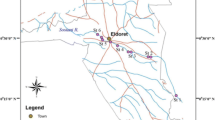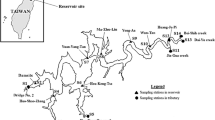Abstract
Jakara River Basin has been extensively studied to assess the overall water quality and to identify the major variables responsible for water quality variations in the basin. A total of 27 sampling points were selected in the riverine network of the Upper Jakara River Basin. Water samples were collected in triplicate and analyzed for physicochemical variables. Pearson product-moment correlation analysis was conducted to evaluate the relationship of water quality parameters and revealed a significant relationship between salinity, conductivity with dissolved solids (DS) and 5-day biochemical oxygen demand (BOD5), chemical oxygen demand (COD), and nitrogen in form of ammonia (NH4). Partial correlation analysis (r p) results showed that there is a strong relationship between salinity and turbidity (r p = 0.930, p = 0.001) and BOD5 and COD (r p = 0.839, p = 0.001) controlling for the linear effects of conductivity and NH4, respectively. Principal component analysis and or factor analysis was used to investigate the origin of each water quality parameter in the Jakara Basin and identified three major factors explaining 68.11 % of the total variance in water quality. The major variations are related to anthropogenic activities (irrigation agricultural, construction activities, clearing of land, and domestic waste disposal) and natural processes (erosion of river bank and runoff). Discriminant analysis (DA) was applied on the dataset to maximize the similarities between group relative to within-group variance of the parameters. DA provided better results with great discriminatory ability using eight variables (DO, BOD5, COD, SS, NH4, conductivity, salinity, and DS) as the most statistically significantly responsible for surface water quality variation in the area. The present study, however, makes several noteworthy contributions to the existing knowledge on the spatial variations of surface water quality and is believed to serve as a baseline data for further studies. Future research should therefore concentrate on the investigation of temporal variations of water quality in the basin.



Similar content being viewed by others
References
Acheampong MA, Paksirajan K, Lens PN (2012) Assessment of the effluent quality from a gold mining industry in Ghana. Environ Sci Pollut Res. doi:10.1007/s11356-012-1312-3
APHA (2005) Standard methods for the examination of water and wastewater. American Water Works Association, Environment Federation, Washington, DC
Aris AZ, Praveena SM, Abdullah MH, Radojevic M (2012) Statistical approaches and hydrochemical modeling of groundwater system in a small tropical island. J Hydroinform 14:206–220
Calijuri ML, Couto EA, Santiago AF, Camargo AR, Silva MD (2012) Evaluation of the influence of natural and anthropogenic processes on water quality in Karstic Region. Water Air Soil Pollut 223:2157–2168. doi:10.1007/s11270-011-1012-5
Cho KH, Park Y, Kang J, Ki SJ, Cha S, Lee SW et al (2009) Interpretation of seasonal water quality variation in the Yeongsan Reservoir, Korea using multivariate statistical analyses. J Hydroinform 59(11):2219–2226
Cukrov N, Tepic N, Omanović D, Logen S, Bura-Nakić S, Vojvodic E et al (2012) Qualitative interpretation of physico-chemical and isotopic parameters in the Krka River (Croatia) assessed by multivariate statistical analysis. Int J Environ Anal Chem 92(10):1187–1199
Dimitrovska O, Markoski B, Toshevska BA, Milevski I, Gorin S (2012) Surface water pollution of major rivers in the Republic of Macedonia. Procedia Environ Sci 14:32–40. doi:10.1016/j.proenv.2012.03.004
Esmaeili A, Moore F (2012) Hydrogeochemical assessment of groundwater in Isfahan province, Iran. Environ Earth Sci 67:107–120. doi:10.1007/s12665-011-1484-z
Gholikandi GB, Haddadi S, Dehghanifard E, Tashayouie HR (2012) Assessment of surface water resources quality in Tehran province, Iran. Desalin Water Treat 37(1–3):8–20
Hair JF, Anderson RE, Tatham RL, William C (1995) Multivariate data analysis with readings. Prentice Hall, Englewood Cliffs
Han S, Kim E, Kim S (2009) The water quality management in the Nakdong River watershed using multivariate statistical techniques. Korean J Civ Eng 13(2):97–105
Helena B, Pardo R, Vega M, Barrado E, Fernandez J, Fernandez L (2000) Temporal evolution of groundwater composition in an alluvial aquifer (Pisuerga River, Spain) by principal component analysis. Water Res 34(3):807–816
Hinton PR, Brownlow C (2004) SPSS explained. Routledge, New York
Hu J, Qiao Y, Zhou L, Li S (2011) Spatiotemporal distributions of nutrients in the downstream from Gezhouba Dam in Yangtze River, China. Environ Sci Pollut Res 19:2849–2859. doi:10.1007/s11356-012-0791-6
Koklu R, Sengorur B, Topal B (2010) Water quality assessment using multivariate statistical methods: a case study of Melen River system (Turkey). Water Resour Manage 24(5):959–978
Kowalkowski T, Zbytniewski R, Szpejna J, Buszewski B (2006) Application of chemometrics in river water classification. Water Res 40(4):744–752
Li Y, Xu L, Li S (2009) Water quality analysis of the Songhua River Basin using multivariate techniques. J Water Resour Prot 1(2):110–121
Liu WC, Yu HL, Chung CE (2011) Assessment of water quality in a subtropical Alpine Lake using multivariate statistical techniques and geostatistical mapping: a case study. Int J Environ Res Public Health 8(4):1126–1140
Mandal P, Upadhyay R, Hasan A (2010) Seasonal and spatial variation of Yamuna River water quality in Delhi, India. Environ Monit Assess 170(1):661–670
Manly BF (2005) Multivariate statistical methods. Chapman & Hall/CRC
McGarigal K, Cushman S, Stafford SG (2000) Multivariate statistics for wildlife and ecology research. Springer, New York
Mouri G, Takizawa S, Oki T (2011) Spatial and temporal variation in nutrient parameters in stream water in a rural–urban catchment, Shikoku, Japan: effects of land cover and human impact. J Environ Manage 92(7):1837–1848
Mustapha A, Aris AZ (2012a) Spatial aspects of surface water quality in the Jakara Basin, Nigeria using chemometric analysis. J Environ Sci Health Part A 47:1455–1465
Mustapha A, Aris AZ (2012b) Multivariate statistical analysis and environmental modeling of heavy metals pollution by industries. Pol J Environ Stud 21:1359–1367
Mustapha A, Nabegu AB (2011) Surface water pollution source identification using principal component analysis and factor analysis in Getsi River, Kano, Nigeria. Austr J Basic Appl Sci 5:1507–1512
Mustapha A, Aris AZ, Juahir H, Ramli MF (2012) Surface water quality contamination source apportionment and physicochemical characterization at the upper section of the Jakara Basin, Nigeria. Arab J Geosci. doi:10.1007/s12517-012-0731-2
Mustapha A, Aris AZ, Ramli MF, Juahir H (2012a) Spatial-temporal variation of surface water quality in the downstream region of the Jakara River, Northwestern Nigeria: a statistical approach. J Environ Sci Health Part A 47:1551–1560
Mustapha A, Aris AZ, Ramli MF, Juahir H (2012b) Temporal aspects of surface water quality variation using robust statistical tools. The Scientific World Journal 2012:294540. doi:10.1100/2012/294540
Onojake MC, Ukerun SO, Iwuoha G (2011) A statistical approach for evaluation of the effects of industrial and municipal wastes on Warri Rivers, Niger Delta, Nigeria. Water Qual Expo Health 3:91–99
Otokunefor TV, Obiukwu C (2005) Impact of refinery effluent on the physicochemical properties of a water body in the Niger delta. Appl Ecol Environ Res 3(1):61–72
Packman JJ, Comings KJ, Booth DB (1999) Using turbidity to determine total suspended solids in urbanizing streams in the Puget lowlands. In: Confronting Uncertainty: Managing Change in Water Resources and the Environment; Canadian Water Resources Association Annual Meeting, Vancouver, BC
Panigrahi S, Acharya BC, Panigrahy RC, Nayak BK, Banarjee K, Sarkar SK (2007) Anthropogenic impact on water quality of Chilika lagoon RAMSAR site: a statistical approach. Wetlands Ecol Manage 15(2):113–126
Papaioannou A, Mavridau A, Hadjichristodoulou C, Papastergiou P, Pappa O, Dovriki E, Rigas I (2010) Application of multivariate statistical methods for groundwater physicochemical and biological quality assessment in the context of public health. Environ Monit Assess 170(1–4):87–97
Pradhan UK, Shirodkar PV, Sahu BK (2009) Physico-chemical characteristics of the coastal water off Devi estuary, Orissa and evaluation of its seasonal changes using chemometric techniques. Curr Sci 96(9):1203–1209
Rani N, Sinha RK, Prasad K, Kedia DK (2011) Assessment of temporal variation in water quality of some important rivers in middle Gangetic Plains, India. Environ Monit Assess 174(1–4):401–415
Rogerson PA (2006) Statistical methods for geography: a student’s guide. Sage, London
Schaefer K, Einax JW (2010) Analytical and chemometric characterization of the Cruces River in South Chile. Environ Sci Pollut Res 17(1):115–123
Shrestha S, Kazama F (2007) Assessment of surface water quality using multivariate statistical techniques: a case study of the Fuji River Basin, Japan. Environ Modell Softw 22:464–475
Shrestha S, Kazama F, Nakamura T (2008) Use of principal component analysis, factor analysis and discriminant analysis to evaluate spatial and temporal variations in water quality of the Mekong River. J Hydroinform 10(1):43–56
Singh KP, Malik A, Mohan D, Sinha S (2004) Multivariate statistical techniques for the evaluation of spatial and temporal variations in water quality of Gomti River (India)—a case study. Water Res 38:3980–3992
Singh KP, Malik A, Mohan D, Sinha S, Singh VK (2005) Chemometric data analysis of pollutants in wastewater: a case study. Anal Chim Acta 532(1):15–25
Singh AK, Mondal GC, Singh TB, Singh S, Tewary BK, Sinha A (2012) Hydrogeochemical processes and quality assessment of groundwater in Dumka and Jamtara districts, Jharkhand, India. Environ Earth Sci 67:2175. doi:10.1007/s12665-012-1658-3
Tanrıverdi Ç, Alp A, Demirkıran AR, Üçkardes F (2010) Assessment of surface water quality of the Ceyhan River Basin, Turkey. Environ Monit Assess 167(1):175–184
Tlili-Zrelli B, Hamzaoui-Azaza F, Gueddari M, Bouhlila R (2012) Geochemistry and quality assessment of groundwater using graphical and multivariate statistical methods. A case study: Grombalia phreatic aquifer (Northeastern Tunisia). Arab J Geosci. doi:10.1007/s12517-012-0617-3
Tobiszewski M, Tsakovski S, Simeonov V, Namiesnik J (2010) Surface water quality assessment by the use of combination of multivariate statistical classification and expert information. Chemosphere 80(7):740–746
Varol M, Gökot B, Bekleyen A, Sen B (2012) Spatial and temporal variations in surface water quality of the dam reservoirs in the Tigris River Basin, Turkey. Catena 92:11–21
Vittori AL, Trivisano C, Gessa C, Gherardi M, Simoni A, Vianello G et al (2010) Quality of municipal wastewater compared to surface waters of the river and crtificial canal network in different areas of the eastern Po Valley (Italy). Water Qual Expo Health 2(1):1–13
Wang Y, Wang P, Bai Y, Tian Z, Li J, Shao X et al (2012) Assessment of surface water quality via multivariate statistical techniques: a case study of the Songhua River Harbin region, China. J Hydro-environ Res. doi:org/10.1016/j.jher.2012.10.003
Wong WS (2005) Using multivariate statistical techniques to examine the spatial variability of physiochemical elements and water quality in Hong Kong’s Rivers. Asian Geographer 24(1):129–150
Zhou F, Liu Y, Guo H (2007) Application of multivariate statistical methods to water quality assessment of the watercourses in Northwestern New Territories, Hong Kong. Environ Monit Assess 132(1–3):1–13
Author information
Authors and Affiliations
Corresponding author
Additional information
Responsible editor: Michael Matthies
Highlights: ►Surface water samples were collected and analyzed in the laboratory. ►Environmentric tools were successfully applied on the datasets. ►Physicochemical parameters’ relations were revealed. ►Water pollution source’s apportionments were identified.
Rights and permissions
About this article
Cite this article
Mustapha, A., Aris, A.Z., Juahir, H. et al. River water quality assessment using environmentric techniques: case study of Jakara River Basin. Environ Sci Pollut Res 20, 5630–5644 (2013). https://doi.org/10.1007/s11356-013-1542-z
Received:
Accepted:
Published:
Issue Date:
DOI: https://doi.org/10.1007/s11356-013-1542-z




